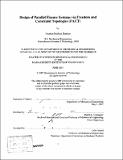Design of parallel flexure systems via Freedom and Constraint Topologies (FACT)
Author(s)
Hopkins, Jonathan B. (Jonathan Brigham)
DownloadFull printable version (71.48Mb)
Other Contributors
Massachusetts Institute of Technology. Dept. of Mechanical Engineering.
Advisor
Martin L. Culpepper.
Terms of use
Metadata
Show full item recordAbstract
The aim of this thesis was to generate the knowledge required to represent the possible freedom topologies (motions of a mechanism) and the possible constraint topologies (flexural elements that guide the mechanism) in a form that designers can use to design parallel flexure systems. The framework that links these topologies enables designers to create three-dimensional, multi-axis flexure systems by using "Freedom and Constraint Topologies" (FACT). FACT embodies every possible design solution for parallel flexure systems. This information enables designers to consider every possible design and then select the design that is best suited for a specific application. FACT was created to improve the design processes for small-scale flexure systems and precision machines. For instance, there is a need to create multi-axis nanopositioners for emerging three-dimensional nano-scale research/manufacturing. (cont.) Through this work the following contributions were made: (1) twenty six unique matching pairs of freedom and constraint spaces were identified; (2) it was proven that these spaces embody all possible solutions; (3) a design process was created to guide a designer from design requirements, to freedom spaces, to constraint spaces, to mechanism designs; (4) a sub-process was created to guide designers in the selection of redundant constraints that help satisfy stiffness and symmetry requirements without altering the mechanism's kinematics; (5) mathematical expressions were created to represent the freedom and constraint spaces in a form that enables computers to identify and manipulate them. In this thesis, three case studies are provided to demonstrate the FACT design process for mechanisms of varying complexity: (1) a compliant spherical ball joint, (2) a compliant probe for a five axis STM, and (3) a compliant rotary flexure are designed. The second case study demonstrates the sub-process for selecting redundant constraints.
Description
Thesis (S.M.)--Massachusetts Institute of Technology, Dept. of Mechanical Engineering, 2007. Includes bibliographical references (p. 391-393).
Date issued
2007Department
Massachusetts Institute of Technology. Department of Mechanical EngineeringPublisher
Massachusetts Institute of Technology
Keywords
Mechanical Engineering.